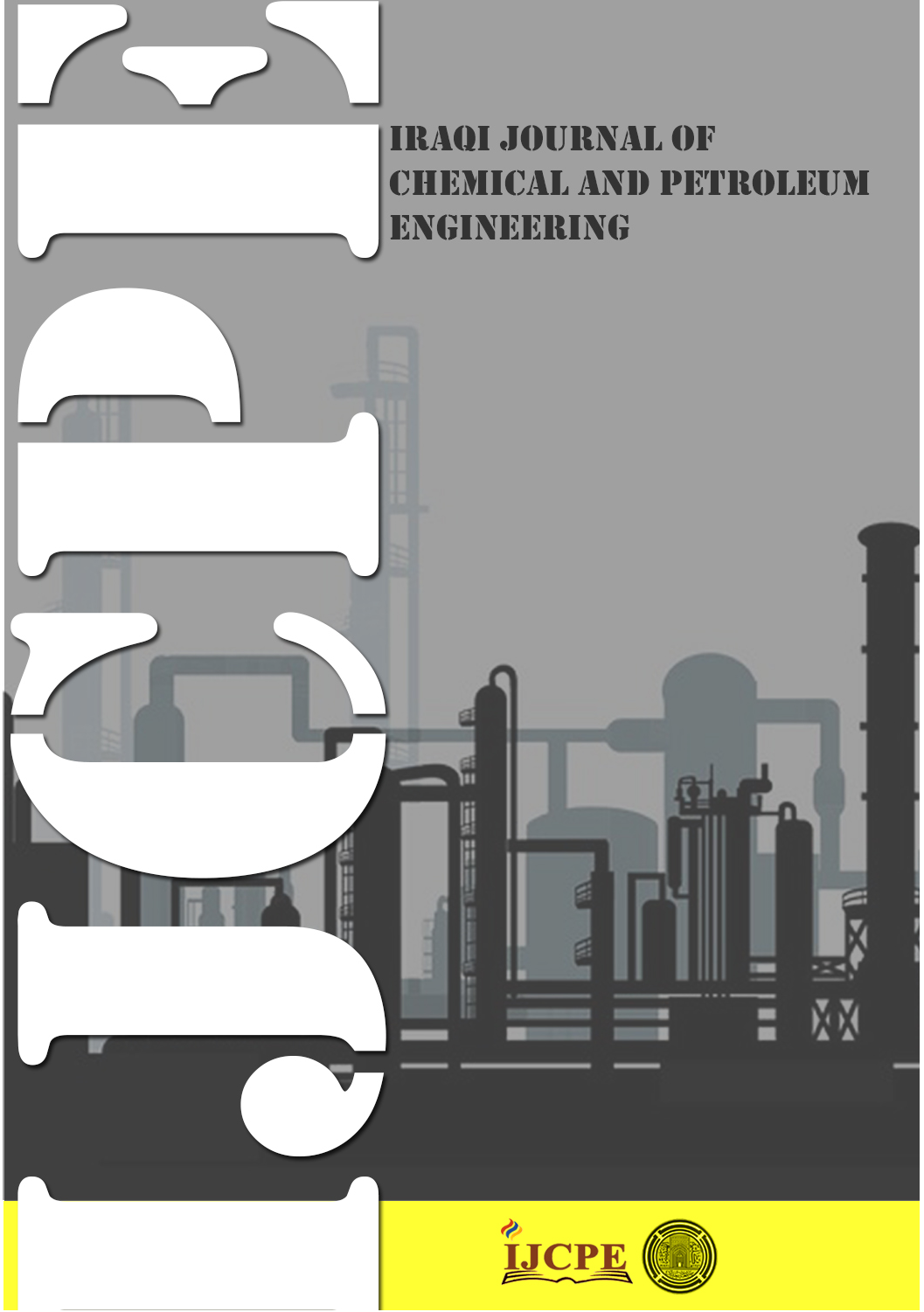Identification and optimization of production bottleneck in a deviated oil well: a case study using nodal analysis
DOI:
https://doi.org/10.31699/IJCPE.2025.2.16Keywords:
Optimization; Nodal analysis; IPR; VLP; phase envelope; ESP; ProsperAbstract
Hydrocarbons play a substantial role in the energy industry; however, maintaining a steady and optimal production rate in deviated wells remains a significant challenge, especially due to flow bottlenecks that reduce output efficiency. This study focuses on identifying and resolving production constraints in a deviated well located in the TK oil field in North Iraq with a total measured depth of 9639.5 ft. The true vertical depth is at 8137 ft. at an inclination angle of 39.90o. The well failed to meet the pre-evaluated rate of 1044 STB/D based on the current conditions. To accomplish the optimum rate, the deviated well S17 is subjected to nodal analysis and various possible alterations in the well geometry and production system. The nodal analysis through the Inflow Performance Relationship and Vertical Lift Performance characteristics is addressed utilizing IPM suites Prosper to replicate the flow in the tubing through integrated correlations, the fluid behavior, and the phase envelope. The saturation pressure is tuned with the correlations in the PVTp program. Different scenarios were set, such as the change in wellhead pressure, tubing internal diameter, reservoir pressure, skin factor, and the introduction of artificial lift. Following the simulation, as referred to previously, the detailed analysis of the variables provides an exhaustive insight for the field operators. The key finding of this well is that reducing skin factor and alongside the use of Electrical submersible pump (ESP) installation, significantly enhance production feasibility and the well will be able to produce when the reservoir pressure drops to 1500 psi These results provide actionable insides for field operators to improve production performance in similar well conditions.
Received on 11/11/2024
Received in Revised Form on 27/03/2025
Accepted on 29/03/2025
Published on 30/06/2025
References
[1] B.K Raoof; A Rabia, U. Alameedy, P. Shakor, M. Karakouzian, "Synergizing Machine Learning and Physical Models for Enhanced Gas Production Forecasting: A Comparative Study of Short- and Long-Term Feasibility. Energies 2025, 18, 1187. https://doi.org/10.3390/en18051187
[2] U. Alameedy, A. A. Al-Haleem, and A. Almalichy, "Well performance following matrix acidizing treatment: case study of the mi4 unit in Ahdeb Oil Field," Iraqi Journal of Chemical and Petroleum Engineering, vol. 23, no. 4, pp. 7-16, 2022. https://doi.org/10.31699/IJCPE.2022.4.2
[3] F. H. Almahdawi, U. Alameedy, A. Almomen, A. A. Al-Haleem, A. Saadi, and Y. M. Mukhtar, "The impact of acid fracking injection pressure on the carbonate-mischief reservoir: a field investigation," in International Petroleum and Petrochemical Technology Conference, Springer, p. 622-641, 2022. https://doi.org/10.1007/978-981-99-2649-7_54
[4] S. Pham, D. Tran, "Production optimization of a network of multiple wells with each well using a combination of Electrical Submersible Pump and Gas lift", Journal of Petroleum Exploration and Production Technology, 12, 631–659 2022. https://doi.org/10.1007/s13202-021-01313-z
[5] F. Meng, D. He, H. Yan, H. Zhao, H. Zhang, and C. Li, "Production performance analysis for slanted well in multilayer commingled carbonate gas reservoir," Journal of Petroleum Science and Engineering, vol. 204, p. 108769, 2021. https://doi.org/10.1016/j.petrol.2021.108769
[6] U. Alameedy and A. Almomen, "Diagnosing Complex Flow Characteristics of Mishrif Formation in Stimulated Well Using Production Logging Tool," Journal of Petroleum Research and Studies, 2016, vol. 6, p. 12. https://doi.org/10.52716/jprs.v6i2.150
[7] J. R. Ortiz Requena, M. Martinez Santiago, F. M. Alshehhi, F. A. Daudpota, and A. M. Fawzy, "Improving well and reservoir management practice through new flow control philosophy that prolongs the life of production wells affected by water breakthrough in a giant carbonate oil field, Abu Dhabi, United Arab Emirates," in SPE Annual Technical Conference and Exhibition?, 2021: SPE, p.D031S052R007. https://doi.org/10.2118/205978-MS
[8] M. Tavakkoli, S. R. Panuganti, Y. Khemka, H. Valdes, and F. M. Vargas, "Foam-assisted gas lift: A novel experimental setup to investigate the feasibility of using a commercial surfactant for increasing oil well productivity," Journal of Petroleum Science and Engineering, vol. 201, p. 108496, 2021. https://doi.org/10.1016/j.petrol.2021.108496
[9] R. Ashena, M. Bataee, H. Jafarpour, H. Abbasi, A. Zolotukhin, and M. Mirhashemi, "Significant production improvement using optimization of completion and artificial lift: case studies from South-West Iran," Journal of Petroleum Exploration and Production, vol. 11, pp. 359-384, 2021. https://doi.org/10.1007/s13202-020-01053-6
[10] U. A. H. Qasim and D. J. Sadeq, "Nodal Analysis of Naturally Flowing Wells in Faihaa Oil Field, Yamama Formation," The Iraqi Geological Journal, v. 57, n. 18, p. 122-139, 2024. https://doi.org/10.46717/igj.57.1B.10ms-2024-2-19
[11] S. Shadizadeh and M. Zoveydavianpour, "A successful experience in optimization of a production well in a southern Iranian oil field," Iranian Journal of Chemical Engineering, v. 6, n. 2, p. 37-49, 2009.
[12] A. Kumar, M. Vohra, S. Pant, S. K. Singh, "Optimization techniques for petroleum engineering: A brief review,".International Journal of Modelling and Simulation, 2021, 41(5), 326–334. https://doi.org/10.1080/02286203.2021.1983074
[13] O. Arslan, CD. White, AK. Wojtanowicz. "Nodal analysis for oil wells with downhole water sink completions". In PETSOC Canadian International Petroleum Conference, 2004, Jun 8 (pp. PETSOC-2004). https://doi.org/10.2118/2004-242
[14] R. M. Kamga Ngankam, E. D. Dongmo, M. Nitcheu, J. F. Matateyou, G. Kuiatse, and S. Takougang Kingni, "Production Step‐Up of an Oil Well through Nodal Analysis," Journal of engineering, vol. 2022, no. 1, p. 6148337, 2022. http://dx.doi.org/10.1155/2022/6148337
[15] F. Thomas, T. Anraku, D. Bennion, and D. Bennion, "Optimizing production from A rich gas condensate reservoir," in SPE Improved Oil Recovery Conference?, 1996: SPE, pp. SPE-35455-MS. http://dx.doi.org/10.2118/35455-MS
[16] S. Sinan, P. W. Glover, and P. Lorinczi, "Modelling the impact of anisotropy on hydrocarbon production in heterogeneous reservoirs," Transport in Porous Media, vol. 133, no. 3, pp. 413-436, 2020. https://doi.org/10.1007/s11242-020-01430-z
[17] D. Ekeke and S. Basu, "OML-XYZ Production System Debottlenecking Using IPM," in SPE Nigeria Annual International Conference and Exhibition, 2014: SPE, pp. SPE-172438-MS. https://doi.org/10.2118/172438-MS
[18] B. Zohuri, Physics of cryogenics: an ultralow temperature phenomenon. Elsevier, p. 703-710, 2017. http://dx.doi.org/10.1016/C2017-0-01796-2
[19] M. Wiggins, J. Russell, and J. Jennings, "Analytical inflow performance relationships for three-phase flow in bounded reservoirs," in SPE Western Regional Meeting, 1992: SPE, pp. SPE-24055-MS. https://doi.org/10.2118/24055-MS
[20] S. Gasbarri, V. Martinez, J. Garcia, R. Pinto, L. Garcia, and C. Gil, "Inflow performance relationships for heavy oil," in SPE Latin America and Caribbean petroleum engineering conference, 2009: SPE, pp. SPE-122292-MS. https://doi.org/10.2118/122292-MS
[21] L. P. Dake, Fundamentals of reservoir engineering. Elsevier, 1983.
[22] P. Goode and F. Kuchuk, "Inflow performance of horizontal wells," SPE Reservoir Engineering, vol. 6, no. 03, pp. 319-323, 1991. https://doi.org/10.2118/21460-PA
[23] J. Lea and K. Brown, "Production optimization using a computerized well model," in SPE International Oil and Gas Conference and Exhibition in China, 1986: SPE, pp. SPE-14121-MS. https://doi.org/10.2118/14121-MS
[24] Gray, H.E. Vertical Flow Correlation in Gas Wells. User’s Manual for API 14B Surface Controlled Subsurface Safety Valve Sizing Computer Program. 2nd Edition, American Petroleum Institute, Dal-las,1978.
[25] K. Aziz and G. W. Govier, "Pressure drop in wells producing oil and gas," Journal of Canadian Petroleum Technology, vol. 11, no. 03, 1972. https://doi.org/10.2118/72-03-04
[26] G. H. Fancher Jr and K. E. Brown, "Prediction of pressure gradients for multiphase flow in tubing," in SPE Annual Technical Conference and Exhibition, 1962: SPE, pp. SPE-440-MS. https://doi.org/10.2118/440-PA
[27] A. R. Hagedorn and K. E. Brown, "Experimental study of pressure gradients occurring during continuous two-phase flow in small-diameter vertical conduits," Journal of Petroleum Technology, vol. 17, no. 04, pp. 475-484, 1965. https://doi.org/10.2118/940-PA
[28] H. Duns Jr and N. Ros, "Vertical flow of gas and liquid mixtures in wells," in World Petroleum Congress, 1963: WPC, pp. WPC-10132.
[29] J. Orkiszewski, "Predicting two-phase pressure drops in a vertical pipe," Journal of Petroleum Technology, vol. 19, no. 06, pp. 829-838, 1967. https://doi.org/10.2118/1546-PA
[30] "Manual for IPM 11.5," Petroleum expert, 2010.
[31] H. Beggs, ‘Production optimization: using NODAL analysis’. 2003. 2nd Edition. (Tulsa, Okla.: OGCI and Petroskills Publications: Tulsa).
Downloads
Published
Issue
Section
License
Copyright (c) 2025 The Author(s). Published by College of Engineering, University of Baghdad.

This work is licensed under a Creative Commons Attribution 4.0 International License.













